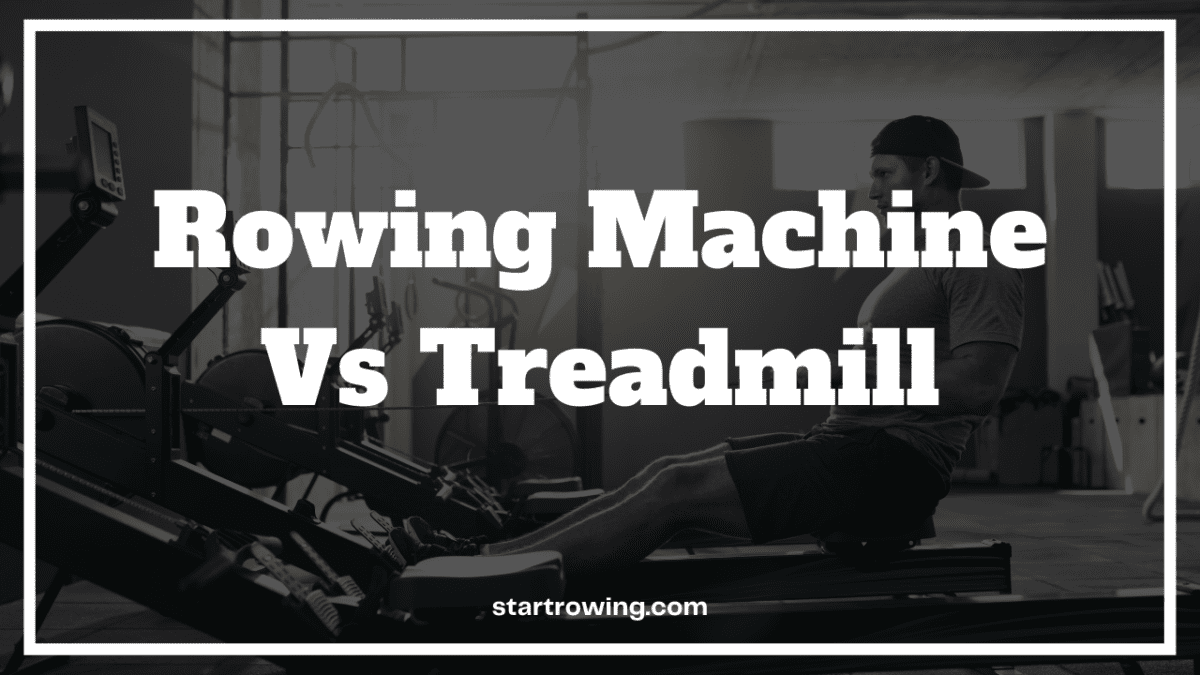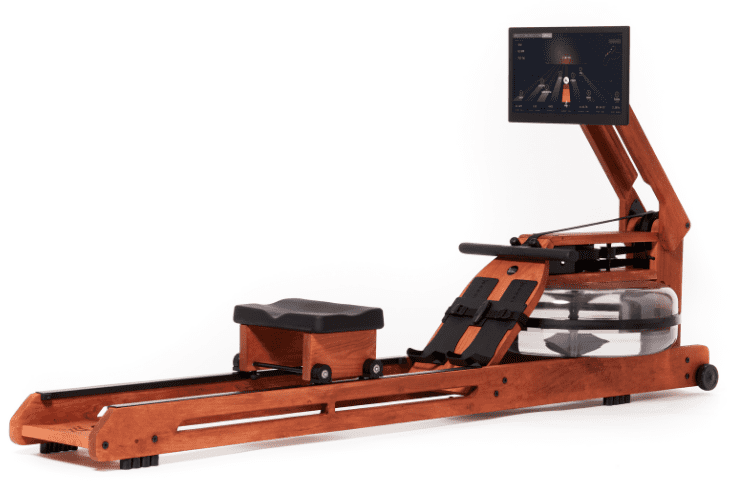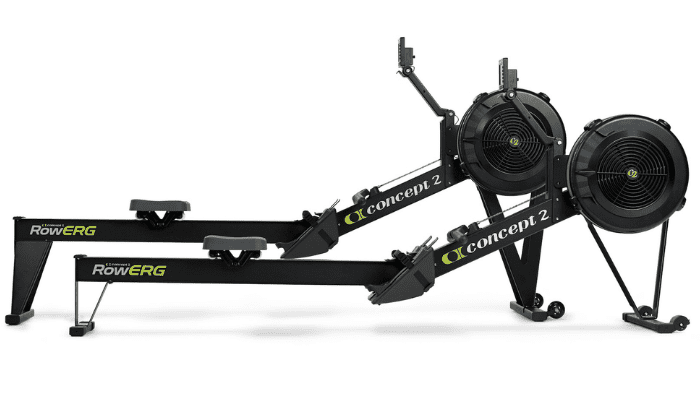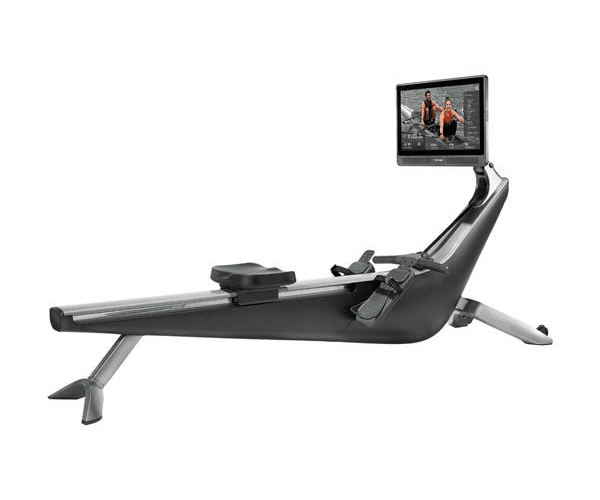When it comes to getting in great cardiovascular shape, losing body fat, and getting aerobically fit there is no shortage of equipment options. Yet, the two most popular, both in commercial and home gym settings, remain the treadmill and the rowing machine.
Both are excellent cardio training tools but if you only had the budget and/or space for one, which would it be?
In this article, I’ll be putting the rowing machine and the treadmill head to head to find out which one is the GOAT when it comes to getting a great workout.
I’ve been managing gyms, training clients, and recommending fitness equipment for close to forty years and over that period, I’ve developed an intimate knowledge of the ins and outs of both the treadmill and the rowing machine. That experience has given me a leg up when it comes to recommending either the rowing machine or the treadmill as the better piece of cardio fitness equipment.
At a Glance
Haven’t got time to read all 3001 words of this comparison between the treadmill and the rowing, machine? No, problem – here’s the Cliff Notes version …
The rowing machine is the overall winner in our breakdown between the rowing machine and the treadmill. Even though the treadmill burns slightly more calories, the rowing machine actually provides better fat-burning potential. It also activates more muscles, especially in the upper body, has better storage potential, has far less joint impact, and represents better value for money.
Check out our list of the best rowing machines available. Or see our favorite 3 rowers below.
In the paragraphs to follow, I’ll break down the use of both the rowing machine and the treadmill, providing a breakdown comparison of their muscle activation, calorie-burning potential, ease of use, safety, value for money, and injury potential. By the time you get to the end, you will know once and for all which is best.
Keep reading to discover whether your primary cardio investment should be in a rowing machine or a treadmill.
Rowing Machines
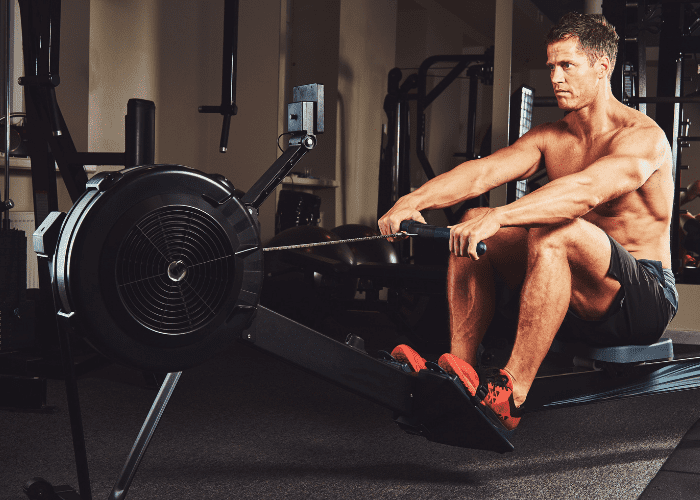
- Burns around 440 calories per 30 minutes
- Works upper body muscles
- Low impact
- Closed chain exercise
The rowing machine has been an exercise staple for more than a hundred years. For most of that time, though, they have been a poor substitute for actually rowing on the water. That changed in the 1980s with the introduction of the ergometer. This device measures the work that is done by the rower, producing a measurement that is known as an erg.
With the advent of the ergometer rowing machine, rowing machines have become commonplace in gyms’ cardio rooms. They are also a very popular home gym item.
There are four varieties of rowing machines that differ according to the type of resistance that they provide:
- Air Rowers feature large fan wheels that are fitted with blades. The resistance is generated by the air as you row. This is an example of a variable resistance rower because the difficulty of the row is determined by the speed with which you are rowing.
- Water Rowers have a water tank at the front of the rower that contains water and blades. The blades connect to the rowing handle by way of a cord. When you row, the blades using and water resistance is generated. This type of rower is considered to be the best simulation of actually rowing on the water.
- Magnetic Resistance Rowers feature a flywheel which is usually located at the front of the machine. This is made of steel. The heavier it is, the more resistance potential the rower will have. On either side of the flywheel are a pair of magnets. A resistance dial allows the user to adjust the distance of the magnets to the flywheel; the closer they are, the greater the resistance.
- Hydraulic Resistance Rowers have a hydraulic piston in the rowing arms, which are connected to the handles. Rather than rowing with a handle that is connected to a cable or a chain, this type of rower simulates the old rowboats with oars at the side of the boats. This is usually the cheapest and least authentic simulation of real rowing on a lake.
Rowing machines have become very popular among general fitness enthusiasts because of their ability to provide a fantastic cardio workout with very little impact. This is considered a closed chain exercise because your feet remain in contact with the foot pedals the whole time, eliminating the impact of footstrike.
The rowing machine also does a much better job of activating the muscles of the upper body than most other cardio exercise options. Virtually all cardio exercises involve the lower body muscles due to some variation of the running action. The rowing machine, as a result of the rowing motion, also brings into play the upper body, mainly the latissimus dorsi, deltoids, biceps, and forearms.
The rowing machine does an effective job of burning calories. According to a Harvard study, a 185-lb person can burn around 440 calories with 30 minutes of intense rowing.
Working out on a rowing machine is not a natural action like walking. As a result, it takes a greater learning curve than a treadmill to learn to row effectively. Interestingly, though, once you do learn how to row with proper form, it is easier to maintain that proper action than when you are running on a treadmill. When you’re on a treadmill, it is easier to get into bad form habits, such as striking with the wrong part of the foot or having an improper gait, hip angle, or arm movement.
Treadmills
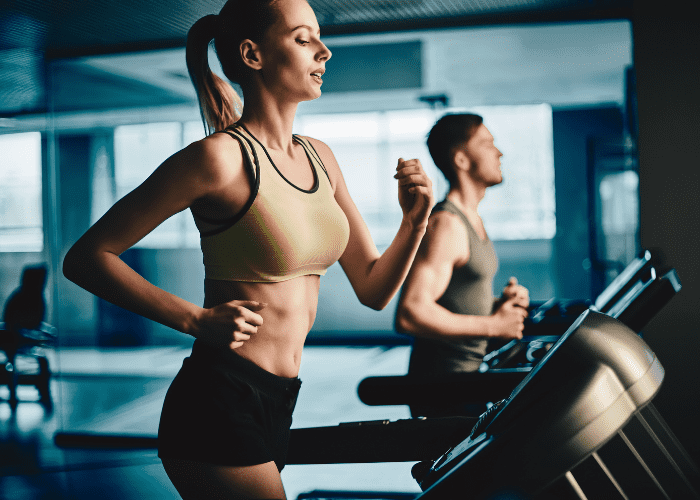
- Easy learning curve
- Range of training intensities
- Burns around 455 calories per 30 minutes
- Some impact
- Open chain exercise
The treadmill has been the most popular form of cardiovascular exercise in gyms for decades. They are also a perennial top seller when it comes to home gym equipment. Treadmills have been on the scene for even longer than rowing machines. However, until around the 1950s, they were self-propelled, not having a motor fitted.
Since the 1990s, the home treadmill market has evolved rapidly. There is now a wide range of treadmills for home use on the market, ranging in price from less than a hundred dollars to several thousand dollars. The electronic treadmill remains the most popular, especially those that are fitted with high-tech monitors. These often include training programs and games to keep you motivated and engaged. You are also able to automatically adjust the incline so that you can run up and down hills and perform wind sprints seamlessly.
In the last few years, the curved manual treadmill has become popular. This version has no motor and is ergonomically designed to encourage a biomechanically enhanced running style. This type of manual treadmill is light years ahead of the old manual treadmills of the 1970s. On it you can generate a great deal of intensity, making the curved manual ideal for high-intensity interval training (HIIT).
Many treadmills today incorporate TV screens and the ability to watch streaming services like Netflix. You can also plug your tablet into the console and access training apps via Bluetooth.
Treadmills allow you to get an excellent calorie burn. In a 30-minute high-intensity run on an electronic treadmill, a 185-pound person will burn around 455 calories. Of course, you will burn fewer calories if you run at a slower pace.
The treadmill will do an effective job of activating the muscles of your lower body, especially the glutes, quadriceps, hamstrings, and calves. However, working out on a treadmill will not effectively stimulate the muscles of the upper body.
The treadmill is an open-chain exercise where your feet come off the foot platform during the exercise. That means that there is a degree of impact resulting from footstrike with every running step that you take. Most modern treadmills do an effective job of minimizing impact from foot strike but there is still a degree of impact on the ankles, knees, and hip joints.
When you exercise on a treadmill, you have a lot of variety in your training options. You can walk at a slow or moderate pace and run from a slow jog to a fast sprint.
Rowing Machine vs Treadmill Comparison
Let’s now consider a head-to-head match-up on the key features and benefits of a treadmill and a rowing machine.
Calorie Burn
Both the treadmill and rowing machine do a good job of burning calories. The treadmill provides greater variety in calorie burn depending on whether you are walking solely or running at full intensity.
A person weighing 185-pounds who is sprinting for 30 minutes on a treadmill will burn around 455 calories. Thirty minutes on a rowing machine at full intensity will burn 440 calories. That puts them pretty much on par, with the treadmill having the slight edge.
Winner: Treadmill
Fat Loss
While calorie burn is an important factor in fat loss, it is not the whole story. Another key factor is your rate of metabolism. It is your metabolism that determines your rate of calorie burn for the 23.5 hours a day that you are not exercising. A key determinant of your metabolism is your level of muscle mass.
Muscle is five times denser than body fat. As a result, it takes five times more energy to sustain an ounce of muscle than it does an ounce of fat.
Even though neither the rowing machine nor the treadmill is a strength and muscle-building machine, one of them does a much better job at building strength and muscle than the other. That one is the rowing machine. Every pull of the handle on the rowing stroke is giving your upper body a resistance workout. It will work your last, your deltoids, your bicep, and your forearms. At the same time, the back and forth movement along the length of the rail will be firing your glutes, quads, hamstrings, and calves.
In contrast to this, the treadmill will do virtually nothing to engage the muscles of your upper body. It will work your legs but with less quad and glute impact than a rowing machine will provide. When it comes to calf stimulation and development, however, you will get better results with a treadmill.
A result of the extra muscle mass that you can gain on the rower increases your metabolism. That is why, even though the treadmill gets the slight edge in terms of calorie burn, the rowing machine is actually a more effective fat burner.
Winner: Rowing Machine
Muscle Activation
The rowing machine does a better job of activating the muscles of your body than the treadmill. We have already covered how the rowing machine activates the muscles of the upper body as well as the lower body. But there’s more; it also does a very good job of activating the core muscles.
As you progress through the drive portion of the row, your core is activated to provide stability to the body. The individual muscles that contract are the rectus abdominis, the obliques, and erector spinae. Your core becomes even more engaged at the finish of the row. At this point, the core has to work even harder to keep the body stabilized. This will call into action the abs, obliques, intercostals, erector spinae, and transverse abdominis.
The treadmill will also activate your core but nowhere near to the degree that the rowing machine does. There is virtually no upper body activation but it will strengthen and build the glutes, quads, hamstrings, and calves.
Winner: Rowing Machine
Impact
The treadmill is an open-chain exercise. Every step that you take on the treadmill lifts your foot up and requires you to put it back down on the running bed. This provides a degree of impact that will be higher the faster that you run.
Modern treadmills do a much better job of minimizing the effect of running on your joints. Most quality treadmills will incorporate some form of high-tech cushioning system that makes working out on the treadmill better for your joints than running on concrete or pavement surfaces.
Rowing on a rowing machine is a close chain exercise. That is because your feet remain in contact with the footplates throughout the entire movement. As a result, there is no footfall involved with the rowing action. This eliminates the resultant ankle, knee, and hip impact that comes with every step you take on a treadmill.
If you are a person who already suffers from some form of joint weakness, a rowing machine will be a better option for you, as it will not put stress on your joints to the degree that a treadmill will.
To ensure that your joints are not negatively impacted when rowing it is important to maintain proper form. This is especially important when it comes to your back positioning. Do not round your back at any time during the rowing action, maintaining a natural neutral lower spine position.
Winner: Rowing Machine
Cardiovascular Conditioning
You can get a very good cardiovascular workout on both the treadmill and the rowing machine. The degree to which you can benefit from an exercise in terms of cardiovascular endurance and heart and lung efficiency depends on the intensity of your workout.
You can go really fast on a treadmill and you can be rowing very intensely on a rowing machine. However, treadmill speeds are sometimes limiting. If you exercising on an air or water rower, however, you are in charge of the resistance so there is no limit to how fast you can go.
When it comes to high-intensity interval training (HIIT), you can get a good workout on the treadmill and the rowing machine. However, the variable resistance of the rower again gives an advantage here. It allows you to instantly transition from fast to slow when doing your HIIT training without having to adjust a resistance dial as you would have to do on a treadmill.
Winner: Rowing Machine.
Value for Money
When it comes to value for money, the rowing machine and treadmill are available at a range of price points from budget (under $500), mid-range ($500-1250), and high-end (1250+). However, if you are wanting a serious workout, you will need to spend more than $1500 on a treadmill. Machines that are sold under that price level will often have a weak motor, an unstable frame, and less than ideal cushioning under the running belt.
In contrast, you can purchase the world’s most popular and highest regarded rowing machine, the Concept2 RowErg for around $1200. The simple truth of the matter is that a treadmill is a far more complex machine with more moving pieces that are more expensive than those found on a rowing machine.
Treadmills, because they are more complex, are also more likely to go wrong than a rowing machine. A rowing machine does not have an electric motor. That means there is no electricity usage, whereas a treadmill will cost you about a dollar for every hour of use.
Winner: Rowing Machine
Storage Space
The ability to store away an exercise machine is an important factor for many people, especially those living in confined spaces. Rowing machines have a very low profile, generally requiring a footprint of around 8 feet by 2 feet. Many of them can be stored in an upright position. Some of them can even be folded down into two parts for storage under a bed or in a cupboard.
Treadmills have a much higher profile and are a lot heavier than a rowing machine. They are usually not foldable and are difficult to store away out of sight. Usually, a treadmill will remain in the place where you work out on it.
Winner: Rowing Machine
Best Overall Workout
Both the treadmill and the rowing machine will give you a very effective workout. However, from our breakdown of the seven points of comparison, it is pretty clear …
The rowing machine is the best overall workout machine. The only area where the treadmill came out on top was in terms of calorie burn. But even then, the extra calorie burn was just 15 calories throughout a 30-minute workout. On all six other categories, fat loss, muscle activation, impact, cardio conditioning, value for money, and storage capability, the rower came out on top.
Winner: Rowing machine
| Treadmill | Rowing Machine | |
| Joint Impact | Medium | Zero |
| Calorie Burn (30 mins) | 455 | 440 |
| Muscles Activated | Quads, Glutes, Hamstrings, Calves | Lats. Deltoids, Biceps, Forearms, Quads, Glutes, Hamstrings, Calves |
| Storage Capacity | Low | High |
| Value for Money | Moderate / Low | High |
| Suitability for HIIT | Medium | High |
Rowing Machine vs Treadmill: The Winner
When it comes to a head-to-head comparison between the treadmill and the rowing machine, the rowing machine is the clear winner; in fact, it’s pretty close to a knock-out!
The rowing machine allows for a more intense workout, it activates the muscles of both the upper and the lower body, allowing for muscle and strength increase, is far less impacting on the joints, and will produce a greater level of fat burn for the same time investment as a treadmill workout. Throw in the fact that a rowing machine represents better value for money and it’s a no-brainer…
If you’ve got the space and budget for just one home exercise cardio machine, make sure that it is a rowing machine!
A rowing machine is the best choice for you if want…
- A low impact workout
- To work the muscles of both your upper and lower body
- To activate your core as well as maximize your fat burn
A treadmill is the best choice for you if you are …
- A person who loves to run
- Want to focus on calorie burn
- Want to maximize the interactive nature of your workout
Having established that the rowing machine is the best choice for your cardio, fat loss, and general fitness, why not skip over to our reviews of the best rowing machines on the market?
- Best Rowing Machines
- Best Magnetic Rowing Machines
- Best Compact Rowing Machines
- Best Recumbent Bike Rowers
- Best CrossFit Rower
- All Rowing Machine Reviews
FAQ
What is better rowing or treadmill?
Overall, a rowing machine is better than a treadmill. It’s superior in terms of fat loss, muscle activation, impact, cardio conditioning, value for money, and storage capability.
Can you lose belly fat on a rowing machine?
Yes, absolutely! A rowing machine provides better fat-burning potential than a treadmill as a result of the extra muscle mass that you can gain and therefore increase your metabolism.
Is rowing a better workout than running?
A rowing machine allows for a more intense workout, it activates the muscles of both the upper and the lower body, allowing for muscle and strength increase, is far less impacting on the joints, and will produce a greater level of fat burn for the same time investment as a treadmill workout. However, if you love to run, then you will probably prefer using a treadmill.
Is 30 minutes on a rowing machine enough?
Training on a rowing machine for 30 minutes is definitely enough to improve your cardiovascular endurance. Even a 10-15 minutes HIIT style workout will be effective. The most important thing to see great results is to remain consistent and make sure you are training several times a week.

